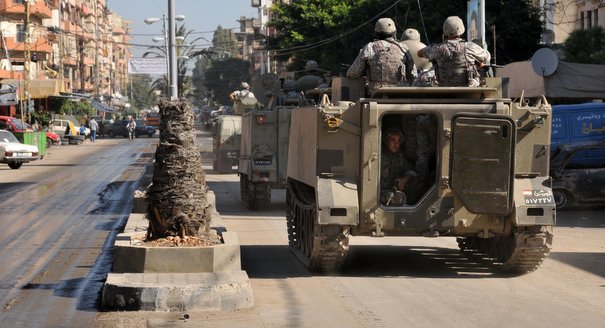Fierce clashes rocked Lebanon on Sunday, October 5, as gunmen aligned with the Nusra Front, a Syria-based al-Qaeda franchise, fought Shia militiamen from the Hezbollah guerrilla force in the eastern Bekaa Valley. More than twenty people were killed. The Bekaa clashes are the latest in a long line of security incidents related to Syria, and tension is rising in all of Lebanon.
A major driver of violence and political tension is Lebanon’s refugee crisis. Three years after the eruption of the Syrian crisis, Lebanese government sources estimate that the country houses more than 2 million Syrian refugees, equivalent to half of the indigenous population, although only around 1.1 million Syrians have so far been officially registered by the UN Refugee Agency.
Tolerance for the refugees is gradually turning into resentment, as Syrians are now present in almost every town and city in Lebanon. According to Lebanese government sources, Syrians occupy 60 percent of the Lebanese labor market, while the economic burden caused by the refugee problem has reached $3 billion, putting severe strain on the national infrastructure. While the international community has repeatedly promised to support the Lebanese government, it has failed to make good on these promises, and Lebanon is now on the verge of a socioeconomic and security explosion.
Social Crisis Breeding Security Problems
The economic and social pressure caused by the refugee crisis has led Lebanese authorities to declare that they will seek to limit the flow of refugees. But this makes it risky for any refugee to return to Syria for fear of not being readmitted into Lebanon. Despite the declaration, some 2,500 refugees still cross the border every day.
Over time, the resources available to support the growing body of Syrian refugees have dwindled. This has led to the rise of human trafficking, prostitution, and other types of criminality in refugee ranks, further increasing tensions with the Lebanese population.
Clashes with local Lebanese residents have led several municipalities to establish restrictions on the freedom of movement of the refugees, especially at night. In addition, municipal security forces are engaging in a mapping and identification process for Syrian refugees living in their vicinity. The unstable security situation and the rise of extremist Syrian groups are making the situation even worse.
The Arsal Battle in August 2014
The clashes in Arsal are a key example. In August 2014, this Sunni-majority border town that has hosted thousands of refugees witnessed a battle between the Lebanese Armed Forces (LAF) and the Nusra Front along with fighters from the al-Qaeda offshoot known as the Islamic State. A couple hundred refugees were mobilized in support of the militants and backed by local Sunni Lebanese. Once a ceasefire was reached, these fighters dissolved into the refugee and local communities in Arsal.
Such events make every Syrian refugee a suspected supporter of the jihadi factions in the eyes of the Lebanese people, who fear the expansion of the Islamic State in Lebanon. Hezbollah’s propaganda has further contributed to a rising fear about the refugees’ potential links with militants. Counterpropaganda by anti-Hezbollah Sunni groups has accused the LAF of being a tool used by Hezbollah to persecute Sunnis in Lebanon, and extremist groups present themselves as protectors of the Sunnis against Shia oppression, generating more support from local Sunnis.
Government and military sources in Lebanon claim that, until now, more than 40 sleeper cells affiliated with either the Islamic State or the Nusra Front have been discovered among the Syrian refugees. In addition, the jihadis took a large number of soldiers and police hostage during the Arsal crisis, and some have since been beheaded. The gruesome killings of LAF personnel—who, being both Sunni and Shia, appear to have been chosen to cut across sectarian lines and divisions in Lebanon—have bred increased antagonism toward the refugees in all of Lebanon’s communities.
Refugee Camps Won’t Solve the Problem
The government’s sole response to this crisis has been to belatedly identify locations where it could establish camps for the refugees on the Syrian side of the border. This proposition has been debated by the government ever since the eruption of the Syrian crisis as a measure to limit the spread of the Syrian refugees on Lebanese territory.
But gathering Syrians in a specific area under the current dire economic and social circumstances would only nurture the radicalization of a refugee community left with few options for survival, and it would further polarize the Lebanese community. Moreover, such a camp could not host more than 120,000 refugees, leaving the destiny of the rest of the approximately 2 million refugees uncertain.
Raising the Risk of Civil War
Prior to Lebanon’s own civil war of 1975–1990, a similar trend was witnessed among the Palestinian refugees. Palestinian refugee camps became safe havens for armed factions and militant leaders who ended up playing an integral part in the civil war as they joined with sympathetic Lebanese militants. This history now seems to be playing out again in the Syrian refugee community.
The Lebanese government is incapable of dealing with the consequences of the flow of refugees alone without major financial, logistical, and security assistance from the international community—and mere promises won’t suffice.
In addition, the LAF and other security institutions are in need of weapons and equipment to fight the expansion of extremist groups and preserve Lebanon’s stability. Without such support, the ingredients for civil strife in Lebanon are likely to tip the country into open-ended instability.






